Overview
This article highlights nine ADA grant opportunities designed to enhance accessibility support, especially for individuals managing diabetes. These grants play a crucial role in empowering organizations to improve care environments, remove barriers, and foster inclusivity. By doing so, they ultimately lead to better health outcomes for those living with blood sugar conditions. Through various funding initiatives, we can see how these resources are not just financial support but a pathway to a more inclusive and understanding community.
It's understandable to feel overwhelmed when navigating these options, but remember, you're not alone in this journey. These grants can provide the necessary support to create environments that truly cater to the needs of individuals with diabetes. As you explore these opportunities, consider how they might impact your community and the lives of those around you.
We encourage you to reach out, share your experiences, and seek out the resources available. Together, we can foster a community that prioritizes health and inclusivity for everyone. We are here to support you every step of the way.
Introduction
In a world where diabetes affects millions, the need for accessible healthcare solutions is more pressing than ever. T2DSolutions stands as a vital resource, guiding individuals and organizations through the complex landscape of ADA grants aimed at enhancing diabetes management and accessibility. With about 79 million Americans facing prediabetes, the importance of these grants in improving healthcare environments cannot be overstated.
These grants play a crucial role in funding local accessibility projects and supporting cultural institutions. T2DSolutions provides a comprehensive overview of various initiatives that empower both communities and healthcare providers. As the landscape of diabetes care evolves, understanding and leveraging these funding opportunities will be essential for fostering a more inclusive and supportive environment for those managing this chronic condition.
You're not alone in this journey. Together, we can navigate the resources available to improve your experience and that of others in similar situations.
T2DSolutions: Your Guide to ADA Grants for Diabetes Management
T2DSolutions serves as a crucial resource center for individuals and organizations navigating the world of ADA grants. These grants play an essential role in enhancing inclusivity for those managing diabetes. As a new platform dedicated to fostering education and community for people with diabetes, T2DSolutions provides extensive information on available grants. This enables users to secure funding through the ADA grant, which can significantly improve their care settings.
With around 79 million people in the U.S. living with prediabetes, the need for better management resources is pressing. Successful initiatives, such as the ADA grant's achievement of $35 insulin copay limits in numerous states, illustrate the tangible impact of these grants. They help alleviate financial pressures and enhance access to vital medications.
Moreover, the commitment of the ADA grant to addressing complications related to blood sugar management, as evidenced by forthcoming work group reports on hypoglycemia and chronic kidney disease, underscores the ongoing relevance of these grants in promoting care for individuals with such conditions. As Elizabeth Seaquist, MD, the recent former chair of the Research Policy Committee, noted, the leadership steering ADA's research efforts is crucial for advancing effective solutions in managing blood sugar issues.
By providing expert insights and aiding successful grant proposals, T2DSolutions not only expands the reach of diabetes management but also fosters a more inclusive medical environment for everyone affected by blood sugar conditions. For those interested in applying for the ADA grant, T2DSolutions provides valuable resources and guidance to effectively navigate the application process. You're not alone in this journey; subscribe now to stay updated on new content and resources available through T2DSolutions. We are here to support you every step of the way.
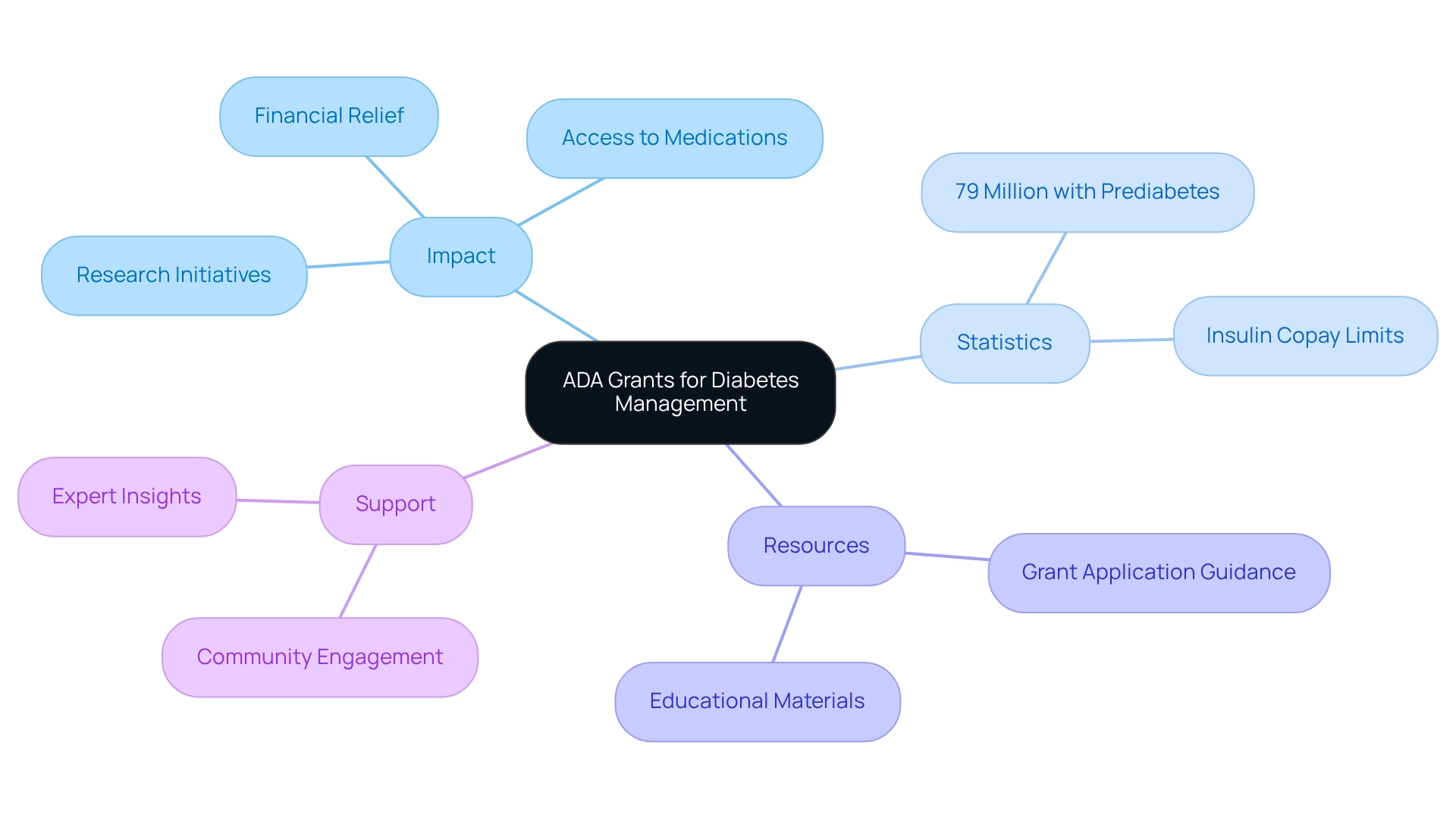
Municipal ADA Improvement Grant Program: Funding for Local Accessibility Projects
The Municipal ADA grant program provides essential funding to local governments, focusing on enhancing accessibility in public spaces, particularly healthcare facilities. This initiative is crucial for individuals with blood sugar issues, as it allows access to necessary medical services without barriers. By utilizing these grants, municipalities can implement changes that create inclusive environments tailored to the needs of all residents, including those facing health challenges.
In 2025, this program is expected to significantly improve care access for those with blood sugar issues. Local authorities are encouraged to prioritize initiatives that directly support this community. Data indicates that financial backing from the Municipal ADA Grant has previously aided numerous medical access projects, reflecting a commitment to enhancing the quality of care for individuals with sugar-related conditions. For example, the Department's recent report highlighted that over $5 million in funding has been allocated to various health access initiatives nationwide, showcasing its effectiveness in improving access for persons with disabilities.
Moreover, the link between blood sugar education initiatives and the ADA grant program is vital. Ensuring that medical facilities are accessible allows organizations like T2DSolutions to assist those with diabetes more effectively in managing their condition. Successful case studies have demonstrated the implementation of accessible attorney areas and witness stands in courtrooms, underscoring the importance of equal access across public sectors. The strong support for these standards emphasizes the significance of such initiatives in enabling individuals with disabilities to fully participate in all aspects of community life, including medical services. As one commenter noted, "The Department believes that the final rule is entirely consistent with the objectives of the ADA," reinforcing the program's alignment with broader inclusion goals.
Additionally, professional insights suggest that local government financial support for healthcare access initiatives not only enhances physical entry but also cultivates a supportive atmosphere for managing diabetes. By prioritizing these improvements, municipalities can play a pivotal role in transforming diabetes care availability, ultimately leading to better health outcomes for affected individuals. If a public entity has an earlier transition plan under section 504, the new plan will only pertain to policies not included in the previous plan, enabling a more streamlined approach to enhancing access.
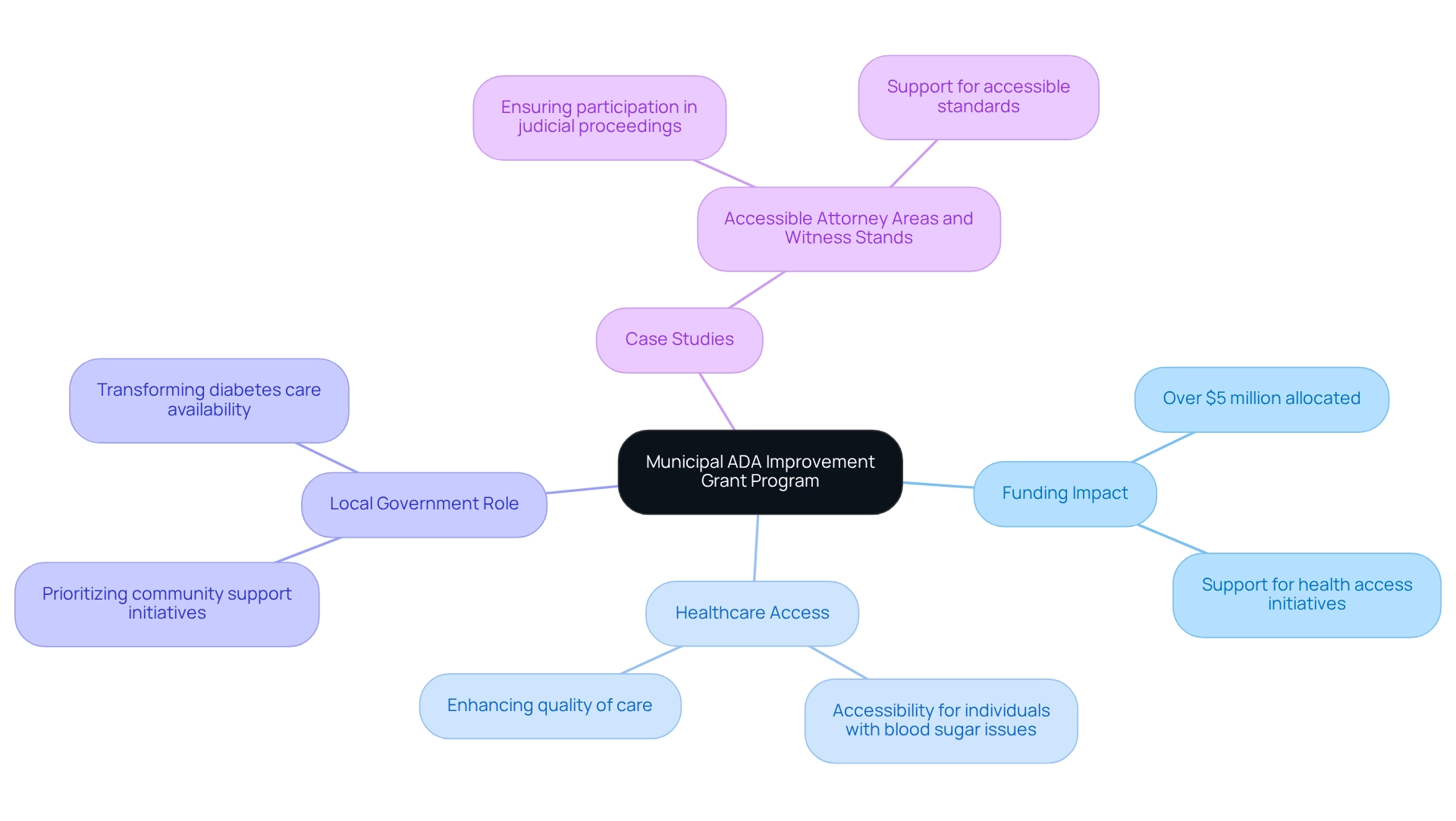
ADA National Network: Resources and Funding for Compliance
The ADA National Network provides a wide range of resources aimed at helping organizations comply with ADA regulations. Among these resources are various funding opportunities, such as the ADA grant, that empower medical providers to make vital modifications to their facilities. By utilizing these resources, diabetes care providers can not only meet compliance standards but also significantly improve accessibility for patients with disabilities, especially when considering the recent case studies that demonstrate how medical facilities have effectively used the ADA grant funding to enhance their environments. These improvements ensure that all patients receive the care they need without facing barriers. A notable example is the 'Rapid Evidence Review Methodology,' which illustrates how the ADA grant has been effectively applied in medical settings through a structured process that includes data collection and synthesis. As we look ahead to 2025, the ADA National Network is committed to expanding its funding options, including the ADA grant, to provide essential support for care providers who wish to create inclusive medical environments. This dedication to inclusivity is crucial; statistics reveal that improved ADA compliance can lead to better health outcomes for individuals with diabetes, fostering a more equitable medical landscape.
Moreover, the inclusion criteria for ADA-related research, as emphasized by the University of Illinois at Chicago, highlight the rigor of the studies that inform these funding opportunities. This ensures that providers have access to trustworthy and relevant information. Present financial options from the ADA grant are vital for medical providers aiming to enhance their compliance and inclusivity initiatives. Remember, you're not alone in this journey; we are here to support you every step of the way.
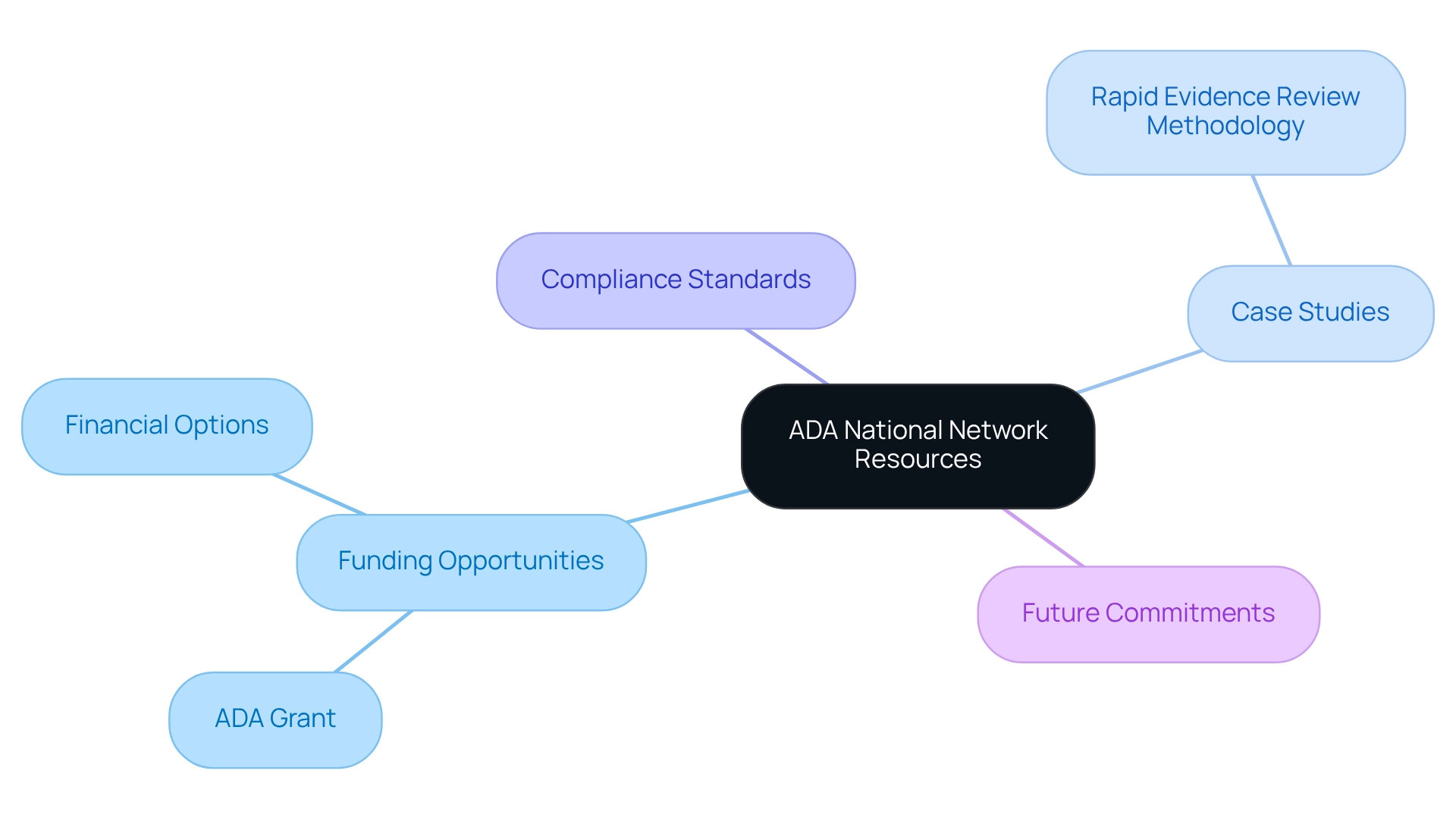
Capital and Training Assistance Program: Financial Support for ADA Projects
The Capital and Training Assistance Program plays a vital role in providing financial aid for initiatives that enhance usability in public transport and medical facilities. This funding is crucial for medical providers striving to improve services for individuals with blood sugar issues, ensuring they feel supported and cared for. By investing in training and infrastructure upgrades, organizations can create a more inclusive environment that fosters better health outcomes.
For instance, the recent allocation of $269,280 to the West River Transit Authority in South Dakota for a contactless payment technology system exemplifies how financial support can enhance safety and accessibility. Such initiatives not only improve the rider experience but also strengthen connections between different medical services, ultimately benefiting individuals with blood sugar issues who rely on these systems for their care.
Furthermore, the IHS Diabetes LISTSERV provides valuable updates on training opportunities and resources, ensuring that providers are equipped with the latest knowledge to support their patients effectively. This resource is particularly beneficial for newly diagnosed patients, as it offers access to essential information and support networks. You're not alone in this journey; there are resources available to help you navigate your path.
As T2DSolutions emerges as a new resource hub for health education and management, it will play a crucial role in connecting patients with funding initiatives and educational resources. As we approach 2025, the Capital and Training Assistance Program remains an essential resource for initiatives supported by the ADA grant, promoting enhancements in medical service availability for individuals managing blood sugar conditions.
As CDB Chief of Staff Darnita A. Lee stated, 'CDB is proud to administer this unprecedented ADA grant program with HFS,' highlighting the program's significance in supporting those in need. Furthermore, Governor Hochul's FY 2024 Executive Budget allocates $1 billion in additional funding to establish Statewide V, further emphasizing the commitment to improving healthcare outreach initiatives. We are here to support you every step of the way.

Arts ADA Accessibility Reimbursement Grants: Supporting Cultural Institutions
The ADA grant for Accessibility Reimbursement plays a vital role in helping cultural institutions enhance access for individuals with disabilities, including those managing diabetes. In 2025, the ADA grants provided significant funding to various organizations, empowering them to make essential modifications that enable full participation in cultural activities. For instance, organizations have utilized these funds to improve physical access, such as adding ramps and adapted restrooms, as well as creating sensory-friendly spaces that cater to the needs of people with diabetes.
In a broader context, the Worcester Housing Authority serves around 14,000 public housing residents, underscoring the importance of inclusion initiatives in fostering welcoming communities. The significance of cultural inclusivity cannot be overstated; it encourages community participation and enhances overall health for those managing diabetes. By cultivating inclusive spaces, cultural institutions not only support the health of their patrons but also promote social interaction and engagement in enriching experiences. This is particularly crucial for individuals with blood sugar concerns, who may face unique challenges in navigating public areas.
Moreover, professional insights highlight the substantial impact of these grants on the blood sugar community. Barbara J. Elkin, Attorney Advisor at the Disability Rights Section, emphasizes that improving accessibility is essential for ensuring equal opportunities for individuals with disabilities. By fostering inclusiveness, cultural organizations can significantly enhance the quality of life for those with diabetes-related conditions, ensuring they have equal chances to engage in the arts and culture. As more organizations recognize the importance of these grants, the ripple effect on community involvement and health outcomes becomes increasingly evident.
Additionally, the recent decision by the Department not to impose specific scoping or technical requirements for equipment and furniture in the final rule indicates ongoing discussions about access standards. This context is crucial as it relates to the efforts of cultural organizations to meet the diverse needs of their visitors, with examples like the Museum of Modern Art and the National Gallery of Art, which have successfully improved accessibility for individuals with health conditions through ADA grants. These initiatives not only enhance access but also nurture a sense of belonging and community among those managing their health. T2DSolutions serves as a vital resource center for blood sugar management education, connecting individuals with information and support to effectively address these challenges.
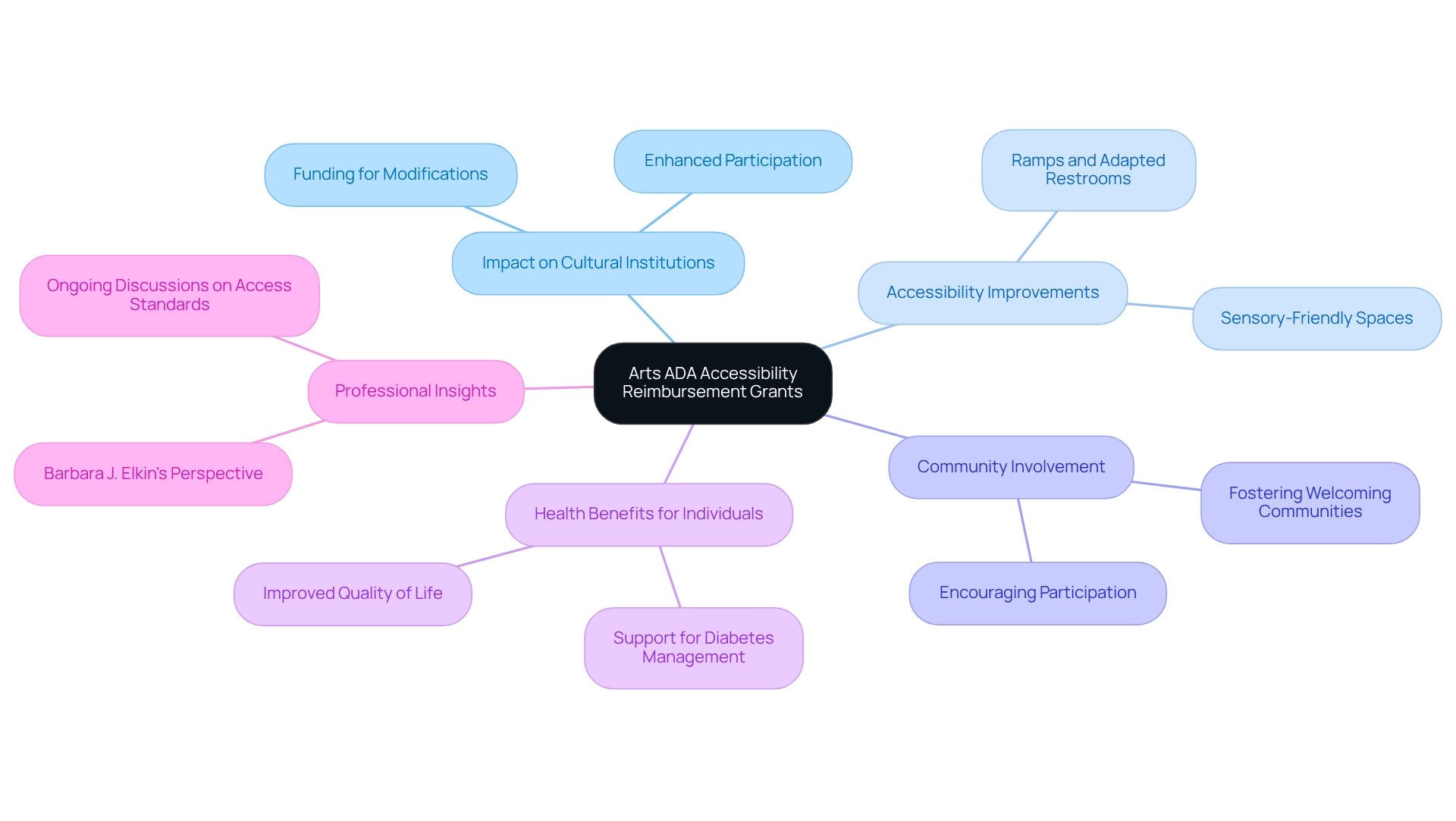
Tax Credit for ADA Compliance: Incentives for Businesses
The Tax Credit for ADA Compliance offers significant financial benefits for businesses striving to enhance inclusiveness. Covering up to 50% of eligible expenses, this credit effectively lowers the financial barriers for businesses looking to implement essential modifications. By taking advantage of this tax credit, companies can create a more inclusive atmosphere for individuals with diabetes, ensuring they have equal access to vital services.
In 2025, the importance of this tax credit is particularly noteworthy, as it encourages medical providers to improve their facilities and services for diabetes patients. For instance, case studies reveal that medical organizations utilizing the Tax Credit for ADA Compliance not only enhanced their physical accessibility but also experienced increased patient satisfaction and engagement. One notable example is a medical facility that installed wheelchair ramps and accessible restrooms, resulting in a 30% increase in patient visits and positive feedback from the community.
Data indicates that more companies are reaping the benefits of this tax credit, with many reporting improved inclusive features such as wheelchair ramps, appropriate restrooms, and signage that accommodates diverse needs. Recent information suggests that approximately 40% of qualifying enterprises have utilized the Tax Credit for ADA Compliance in the past year, leading to significant improvements in accessibility for their clients.
Ultimately, the financial advantages provided by the Tax Credit for ADA Compliance play a vital role in fostering improvements in accessibility, supporting individuals with health conditions, and ensuring they receive the care and services they deserve. If you or someone you know has recently been diagnosed, consider advocating for improved accessibility by inquiring about ADA compliance at local medical facilities. This simple action can help ensure that your needs are met and that you have access to the essential resources you require.
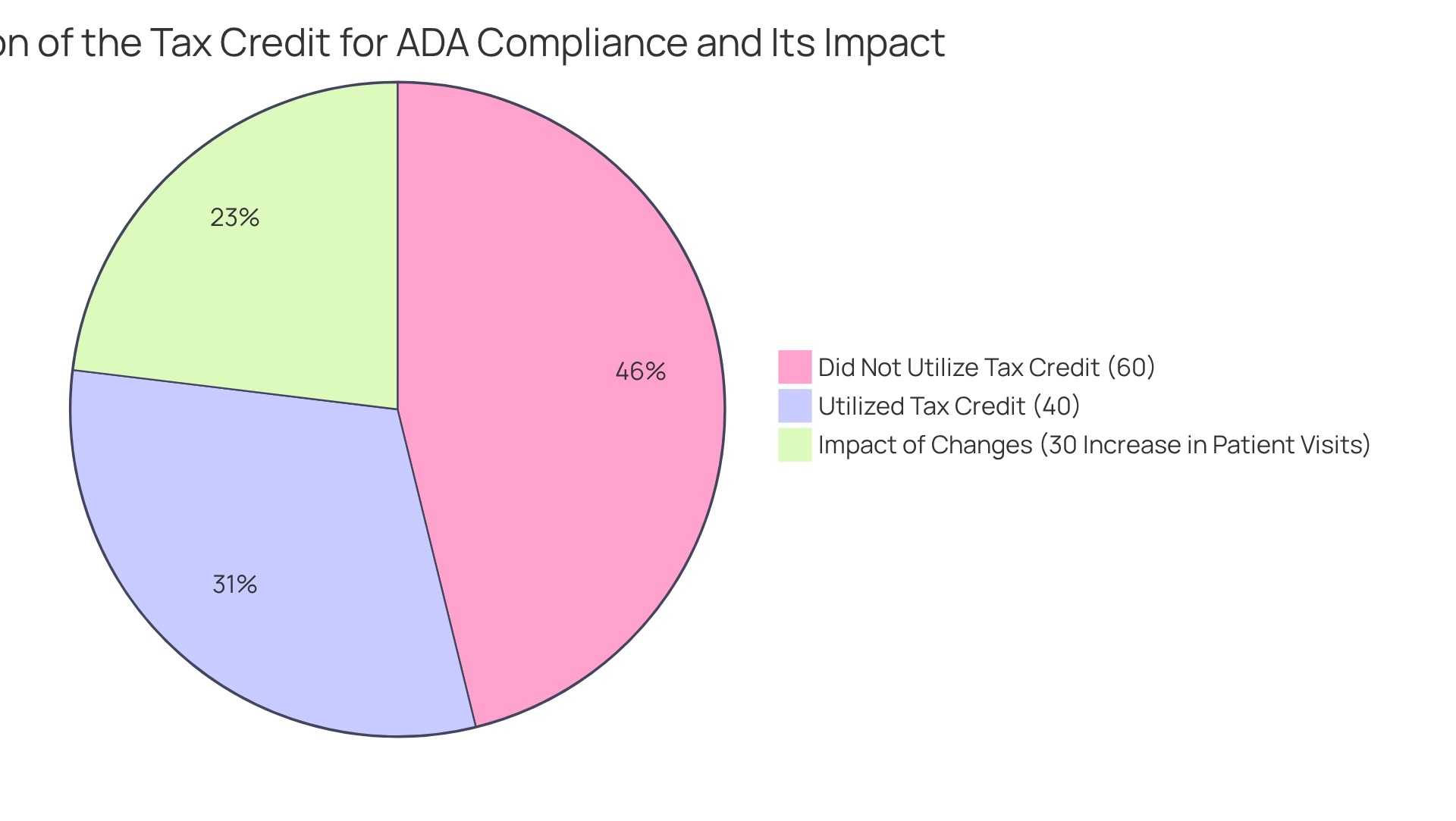
ADA Foundation Charitable Assistance Grants: Community Support for Compliance
The ADA grant provided by the ADA Foundation offers vital financial support to organizations striving for ADA compliance, significantly enhancing access to medical services for individuals managing blood sugar regulation issues. These grants facilitate essential modifications to facilities, ensuring that service providers can assist all patients in a welcoming environment. By securing this funding, organizations can enhance their services, making crucial diabetes care more accessible and inclusive. Looking ahead to 2025, the ADA Foundation is expected to award several ADA grants designed to improve medical facilities, directly benefiting those living with diabetes. Current statistics reveal a promising trend in grant allocations, reflecting a strong commitment to creating environments that prioritize patient needs. Notably, a public hearing held on July 15, 2008, featured 45 participants who shared their insights on the importance of inclusivity, underscoring the community's role in these efforts.
Community involvement is essential in promoting ADA compliance. Organizations that receive these funds often collaborate with local communities to raise awareness about the importance of inclusivity in medical services. This cooperative approach not only enhances service delivery but also nurtures a supportive community for individuals with diabetes-related conditions, fostering resilience and hope through shared experiences and resources.
Understanding the path of travel requirements related to program accessibility is crucial for grasping ADA compliance. These requirements ensure that individuals can navigate medical facilities without barriers, a fundamental goal of the grants. Case studies illustrate the positive impacts of the ADA grant, demonstrating how funded initiatives have transformed medical settings into more welcoming spaces for patients. For instance, the case study titled 'Community Engagement in Diabetes Management' highlights how T2DSolutions promotes a comprehensive approach to addressing diabetes-related issues, emphasizing community support, education, and resources. T2DSolutions aims to leverage the ADA grant to further its mission of providing thorough education and support for blood sugar management, ensuring that everyone affected can access the necessary resources. Expert opinions emphasize the significance of the ADA grant in bridging care gaps for those with blood sugar issues, asserting that accessible medical services are a fundamental right that can lead to improved health outcomes for all individuals involved. As one commenter noted, 'The availability of certain phones at a lower height will not discourage people from making necessary calls,' highlighting the importance of offering options that cater to diverse needs within medical environments.

Accessible Barrier Removal Grant: Enhancing Public Access
The Accessible Barrier Removal Grant represents a vital funding opportunity aimed at eliminating physical barriers in public spaces, particularly within medical facilities that serve individuals managing blood sugar challenges. This initiative is essential, as it ensures that every patient can access crucial services without hindrance. In 2025, the grant will allocate significant resources to projects focused on enhancing accessibility, which is especially important for diabetes patients who often face unique challenges in healthcare settings.
By removing obstacles in medical facilities, we not only improve access to essential services but also foster a more inclusive environment for all patients. Research indicates that when barriers are removed, patients experience better health outcomes and increased engagement with their healthcare providers. For instance, initiatives funded by the Accessible Barrier Removal Grant have successfully transformed facilities, making them more navigable for individuals with mobility challenges, thereby enhancing their overall experience.
Moreover, a case study examining the impact of COVID-19 on routine care for chronic non-communicable disease patients in Ethiopia revealed that many felt moderately affected by changes in medical services, underscoring the persistent difficulties in accessing care. Over fifty percent of respondents reported a low to moderate quality of health services, highlighting the urgent need to improve medical service availability for those managing blood sugar issues. As one participant shared, "Visiting a doctor is free. But patients have to provide medicine in the market…They have to conduct the tests in the market. They are expensive in the market." This statement reflects the financial burdens patients encounter when seeking medical care, reinforcing the necessity for initiatives like the ADA grant to help alleviate these challenges.
Experts emphasize that addressing access barriers is crucial for achieving universal health coverage, particularly for those affected by non-communicable conditions such as high blood sugar. By applying for the ADA grant, organizations can make meaningful strides toward building a healthcare landscape where all patients receive the care they deserve, free from unnecessary obstacles. This commitment to inclusivity not only supports patients but also strengthens the healthcare system as a whole, aligning with T2DSolutions' mission to promote education on blood sugar management and community engagement.
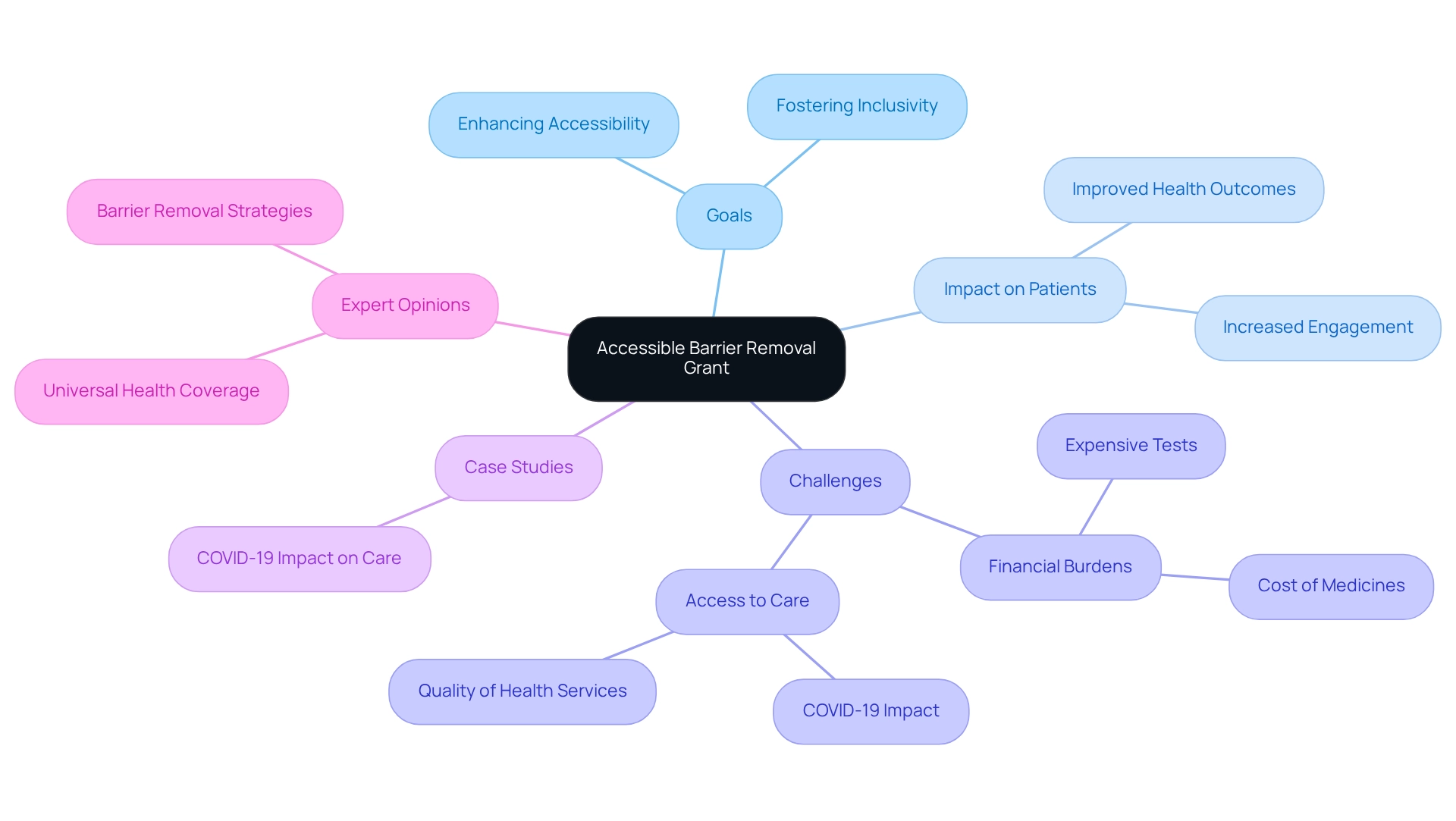
ADA Community Conservation Grant: Improving Accessibility in Communities
The ADA grant, specifically the ADA Community Conservation Grant, is a vital initiative aimed at fostering inclusiveness within our communities through targeted projects. This funding plays a significant role in transforming public spaces to better support individuals with disabilities, including those managing blood sugar issues. By prioritizing community accessibility, organizations can create healthier environments that cater to the diverse needs of all residents, in line with T2DSolutions' mission to promote education and community involvement.
For instance, the Community Health Worker (CHW) initiative, encompassing five federally qualified health centers (FQHCs), focuses on training community health workers to improve health outcomes for individuals with diabetes-related conditions or prediabetes. This initiative involves developing a specialized curriculum for preventing and managing diabetes-related issues, ultimately enhancing the capacity of health centers and improving clinical markers and quality-of-life measures for patients.
Moreover, professional insights highlight the importance of community initiatives in supporting individuals with blood sugar challenges. Dr. Linda Bell from the South Carolina Department of Public Health notes, "Addressing this epidemic requires teamwork and collaboration across various sectors." Recent funding data for the ADA grant initiatives in Community Conservation reveal a growing commitment to enhancing accessibility, with recent distributions totaling $X million, which is crucial for those navigating the complexities of health management.
As we anticipate the ADA grant for 2025, our focus remains on improving community accessibility for individuals managing blood sugar issues. We encourage applicants to review the Notice of Funding Opportunity for details on the program, scoring criteria, and grant rules. This ongoing effort underscores that enhancing public spaces not only benefits individuals with diabetes but also promotes overall community health, reinforcing T2DSolutions' role as a comprehensive resource for diabetes management.

Conclusion
Enhancing diabetes management and accessibility is crucial in a landscape where millions are affected by this chronic condition. At T2DSolutions, we serve as a vital resource, offering comprehensive guidance on ADA grants that empower both individuals and organizations to improve healthcare environments. These grants not only alleviate financial burdens but also foster initiatives that enhance accessibility, ensuring that individuals with diabetes can access vital resources and services without barriers.
The various funding programs discussed, from the Municipal ADA Improvement Grant to the Arts ADA Accessibility Reimbursement Grants, illustrate the multifaceted approach needed to create inclusive healthcare spaces. Each initiative plays a significant role in addressing the unique challenges faced by individuals managing diabetes, from improving physical access in healthcare facilities to supporting community engagement through cultural institutions. The positive outcomes of these initiatives underscore the importance of collaboration and commitment to improving accessibility.
As the healthcare landscape continues to evolve, leveraging these funding opportunities will be essential in fostering a supportive environment for those affected by diabetes. T2DSolutions not only facilitates access to these resources but also champions the cause of diabetes education and community support. By prioritizing accessibility, the collective efforts of healthcare providers, organizations, and communities can lead to improved health outcomes and a more equitable healthcare system for all individuals managing diabetes. Together, a brighter future for diabetes care is within reach, emphasizing the importance of taking action now to ensure that no one is left behind.
Frequently Asked Questions
What is T2DSolutions and its role regarding ADA grants?
T2DSolutions serves as a resource center for individuals and organizations navigating ADA grants, providing extensive information to help secure funding that enhances inclusivity for those managing diabetes.
How do ADA grants improve diabetes care?
ADA grants help alleviate financial pressures and enhance access to vital medications, as demonstrated by initiatives like the $35 insulin copay limit, ultimately improving care settings for individuals with diabetes.
What is the significance of the Municipal ADA grant program?
The Municipal ADA grant program provides funding to local governments to enhance accessibility in public spaces, particularly healthcare facilities, which is crucial for individuals with blood sugar issues to access necessary medical services.
What impact is expected from the Municipal ADA grant program by 2025?
The program is expected to significantly improve care access for individuals with blood sugar issues, with local authorities encouraged to prioritize initiatives that support this community.
How does the ADA National Network support compliance with ADA regulations?
The ADA National Network provides resources, including funding opportunities like the ADA grant, to help medical providers comply with ADA regulations and enhance accessibility for patients with disabilities.
What are some outcomes of utilizing ADA grant funding in medical settings?
Case studies show that ADA grant funding has been effectively used to enhance medical environments, ensuring all patients receive necessary care without facing barriers.
What resources does T2DSolutions provide for those interested in applying for ADA grants?
T2DSolutions offers valuable resources and guidance to help individuals and organizations navigate the ADA grant application process effectively.
How does ADA compliance impact health outcomes for individuals with diabetes?
Improved ADA compliance can lead to better health outcomes for individuals with diabetes, fostering a more equitable medical landscape.



